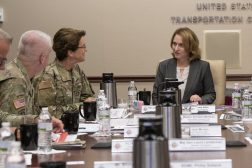Hyten calls on defense industry to deliver more timely solutions

The military’s No. 2 officer, Gen. John Hyten, wants more from the defense industrial base, saying contractors need to deliver more timely capabilities that offer “integrated deterrence.”
In remarks made Wednesday, the vice chairman of the Joint Chiefs of Staff said industry can support new concepts like Joint Warfighting more effectively. The comments come as Hyten prepares to retire from the military in November after four decades in uniform.
“We are not delivering an end game,” he told an audience at the Space and Missile Defense Symposium Wednesday. “We have to do that.”
Hyten called out one specific need to have more sensors and better data analysis on missile defense. It has been an area where the military has experimented with new types of data integration and collection, but Hyten doesn’t appear satisfied.
“I would like to have overhead sensors that a see everything,” he said.
Hyten is not the only high-ranking officer to ask industry to focus on new tech. Adm. Michael Gilday, chief of naval operations, recently told industry to stop lobbying Congress to require the military to buy old platforms he says it doesn’t need.
“Although it’s in industry’s best interest … building the ships that you want to build, lagging on repairs to ships and submarines, lobbying Congress to buy aircraft that we don’t need … it’s not helpful,” Gilday said at the Navy League’s Sea-Air-Space conference. “It really isn’t in a budget-constrained environment.”
Gilday later added what he does want to see form industry, not just what they should not do: “Industry can help pivot to new technologies and new platforms.”
Hyten said in order to get industry up to speed on the new direction the military wants to experiment in, the Joint Requirements Oversight Council (JROC) will be hosting an industry day where leaders will brief contractors on the Joint Warfighting Concept (JWC). The JROC sets requirements for the military’s platforms and weapon systems and has been working on requirements for more data sharing that services will need to implement in their acquisitions.
The JWC has four pillars that all revolve around having weapon systems that can connect and share data with one another in order to converge their capabilities. They include long rang precision fires, Joint All Domain Command and Control (JADC2), contested logistics and information advantage. All four are predicated on the ability to share data and integrate capabilities, like with JADC2 where all sensors would be able to connect and use artificial intelligence to analyze data coming from a battlefield like a military internet-of-things.




